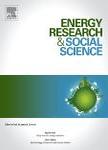版权所有:内蒙古大学图书馆 技术提供:维普资讯• 智图
内蒙古自治区呼和浩特市赛罕区大学西街235号 邮编: 010021

作者机构:Seoul Natl Univ Interdisciplinary Program Landscape Architecture Grad Sch Environm Studies 1 Gwanak Ro Seoul 08826 South Korea Seoul Natl Univ Dept Landscape Architecture Urban Design Concentrat Grad Sch Environm Studies 1 Gwanak Ro Seoul 08826 South Korea Seoul Natl Univ Environm Planning Inst Grad Sch Environm Studies 1 Gwanak Ro Seoul 08826 South Korea
出 版 物:《ENERGY RESEARCH & SOCIAL SCIENCE》 (Energy Res. Soc. Sci.)
年 卷 期:2019年第47卷
页 面:202-214页
核心收录:
学科分类:0830[工学-环境科学与工程(可授工学、理学、农学学位)] 08[工学] 0807[工学-动力工程及工程热物理]
基 金:Basic Science Research Program through the National Research Foundation of Korea (NRF) - Ministry of Science, ICT & Future Planning [NRF-2017R1A1A1A05001205, NRF-2014R1A1A1037046] BK21 Plus Project [F17SN34T1501]
主 题:Fuel poverty Thermal efficiency Actual heating consumption Tenure type Ownership Seoul
摘 要:The study aims to identify residence groups that are highly vulnerable to fuel poverty in the urban area of a South Korean city. Thereby, the paper emphasizes that fuel poverty problems occur in different ways according to the social and spatial contexts and thus need a more contextualized policy approach beyond the simplistic criteria of household income and heating cost. To fully capture the meaning of cold homes, an empirical dataset of thermal efficiency of individual dwellings and actual heating in a residential area in Seoul, South Korea is examined along with the tenure type and the ownership attributes. The analyses reveal that the amount of actual heating energy consumption did not show any clear relation with the thermal efficiency of housing or the tenure type. Additionally, considerably inefficient dwellings like old, detached houses are occupied by elderly owners who often lack both the financial capability and intention to properly maintain their properties. The result indicates that people who are living in cold homes are not always confined to poor residents living in rented homes. The study proposes some new types of potential fuel poverty based on the analyses of thermal efficiency and heating patterns by dwellings.